Any wildlife photographer will tell you that to make great images, what’s almost as important as your camera body is a lens with reach. That’s why the best lenses for wildlife photography are telephoto lenses with a long focal length. Wildlife photographers might keep a wide-angle lens in their kit bag, but by and large they’ll want a long telephoto or telephoto zoom lens in order to get up close.
When choosing the best cameras for wildlife you want a body with speed, and when it comes to the best lenses for wildlife photography this is again a criteria. Along with reach you want a lens with a fast aperture and one that can support your camera’s fast AF performance. But there are some other important considerations.
Yes, your camera cost you a small fortune, but as you develop your skills as a wildlife photographer your greatest expense will be filling your kitbag with lenses. So it’s important make an informed decision.
Zoom lens or prime for wildlife photography?
Do you want the versatility of a zoom lens or the pin sharpness you get from a telephoto prime? A lot of this comes down to personal preference. Zoom lenses give you the flexibility of having a range of focal lengths at your disposal. This means you can mix up your compositions for a variety of image styles.
With a prime lens you are limited to a fixed focal length. However, zoom lenses typically have a varying maximum aperture as you zoom into the telephoto end of the focal range. A prime lens typically has a much wider maximum aperture.
Prime lenses are also typically more expensive than zoom lenses, particularly for telephoto lenses.
What focal length is best for wildlife photography?
How much focal range do you really need to photograph wildlife? This is again down to your subjects and person preference somewhat. A good all-rounder lens kit for wildlife might include 400mm, 70-200mm, 100mm macro and 24-70mm lenses to cover all your options.
But determining what focal length you need really depends on your camera and its sensor type. For instance, a Micro Four Thirds camera has a 2x focal length magnification factor, turning a 300mm lens into a 600mm lens. Likewise, an APS-C format sensor has a 1.5-1.6x focal length magnification, making a 300mm lens look like a 4500mm or 480mm optic.
The best lenses for wildlife photography you can buy today
If you’re new to using long lenses, we’ve got a great guide on what is a telephoto lens and when to use one. In the meantime, these are our picks for the best lenses for wildlife photography, broken down by each camera brand.
Best Canon lenses for wildlife photograhpy
Canon’s growing RF range of lenses offers a number of nice options for wildlife photographers. As well as conventional focal lengths, Canon has been quite creative, offering options for extreme reach at price points that are by no mean out of reach for most photographers.
Canon RF 70-200mm F2.8L IS USM

Specification
- Lens type: Full-frame telephoto zoom
- Mount: Canon RF
- Focal length: 70-200mm
- Maximum aperture: f/2.8
- Minimum aperture: f/32
- Stabilisation: Lens-based to 5EV, up to 7.5EV with the Canon EOS R5 or R6
- Aperture diaphragm blades: 9
- Weather-sealed: Yes
- Close focusing distance: 0.70
- Maximum magnification: 0.23x
- Lens construction: 17 elements in 13 groups
- Filter thread: 77
- Weight: 1070g
- Dimensions: 89.9mm x 146mm
This lens is a kit bag essential for any EOS R mount owner and will enable you to capture subjects using a bright f/2.8 aperture and zoom range.
The lens weighs in at a very slimline 1,070g and measures in at 146mm in length at its shortest. Compared to the EF equivalent, that’s a 28% weight saving and 27% shorter.
This lens also introduced support for an electronic floating focus control that drives the two lens groups individually with Dual Nano USMs. This cutting-edge design helps to provide a high degree of quietness, power saving and high-speed operation without sacrificing the lens’s size and weight.
The Dual Nano USMs enable the RF 70-200mm F2.8L IS USM to achieves high-precision still image AF and smooth movie AF in combination with the EOS R series Dual Pixel CMOS AF.
Filmmakers will welcome the improvements made in the AF design that help to reduce focus breathing, and a 5 Stop IS (Image Stabiliser) enables pin-sharp images even with slow shutter speeds enabling. This marks a vastly improved low light performance compared with the present EF lens.
You can buy the Canon RF 70-200mm F2.8L IS USM at Amazon UK and Amazon US.
£2730
$3699.99For
- Superb image quality in low light
- Much lighter than EF equivalent
Canon RF 100mm F2.8L MACRO IS USM
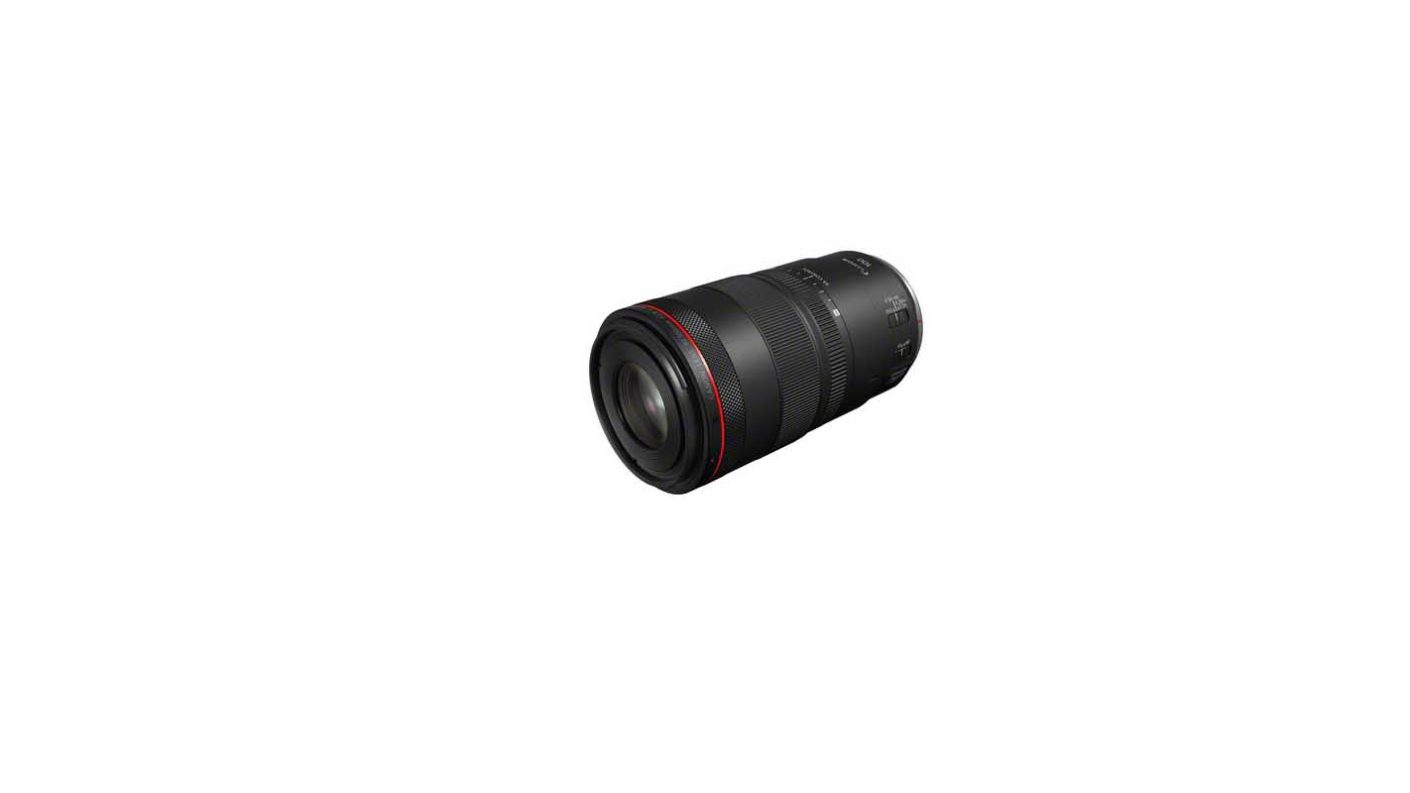
Specification
- Product type: Mid-telephoto macro lens
- Mount: Canon RF
- Format: Full-frame
- Focal length: 100mm
- Maximum aperture: f/2.8
- Minimum aperture: f/32
- Construction: 17 elements in 13 groups
- Focusing system: Dual Nano USM
- Minimum focus distance: 0.26m
- Stabilisation: Yes
- Number of diaphragm blades: 9
- Filter size: 67mm
- Weight: 730g
- Diameter x length (extension from lens mount): 81.5 x 148mm
The Canon RF 100mm F2.8L MACRO IS USM, is the world’s first AF macro lens that offers a 1.4x magnification. Aimed at macro, still life and portrait photographers, its 1.4:1 magnification ratio is delivered by its floating system and short back focusing.
What’s more, the Canon RF 100mm F2.8L MACRO IS USM introduces a new Spherical Aberration Control ring that allows users to adjust the shape and look of the background and foreground bokeh, as well as create a soft focus effect on the subject.
Other features include a maximum f/2.8 aperture for shallow depth of field effects, dual nano USM motors for faster AF and up to five stops of optical image stabilisation (and up to eight stops when used with the Canon EOS R5 or EOS R6).
You can find the Canon RF 100mm F2.8L MACRO IS USM on Amazon UK and Amazon US.
Read our Canon launches RF 100mm F2.8L MACRO IS USM, RF 400mm F2.8L, RF 600mm F4L IS USM lenses
£1499
$1299For
- Stunning 1.4x magnification
- Spherical Aberration Control for adjusting the size of your bokeh
- Built-in stabilisation
Canon RF 600mm F11 IS STM
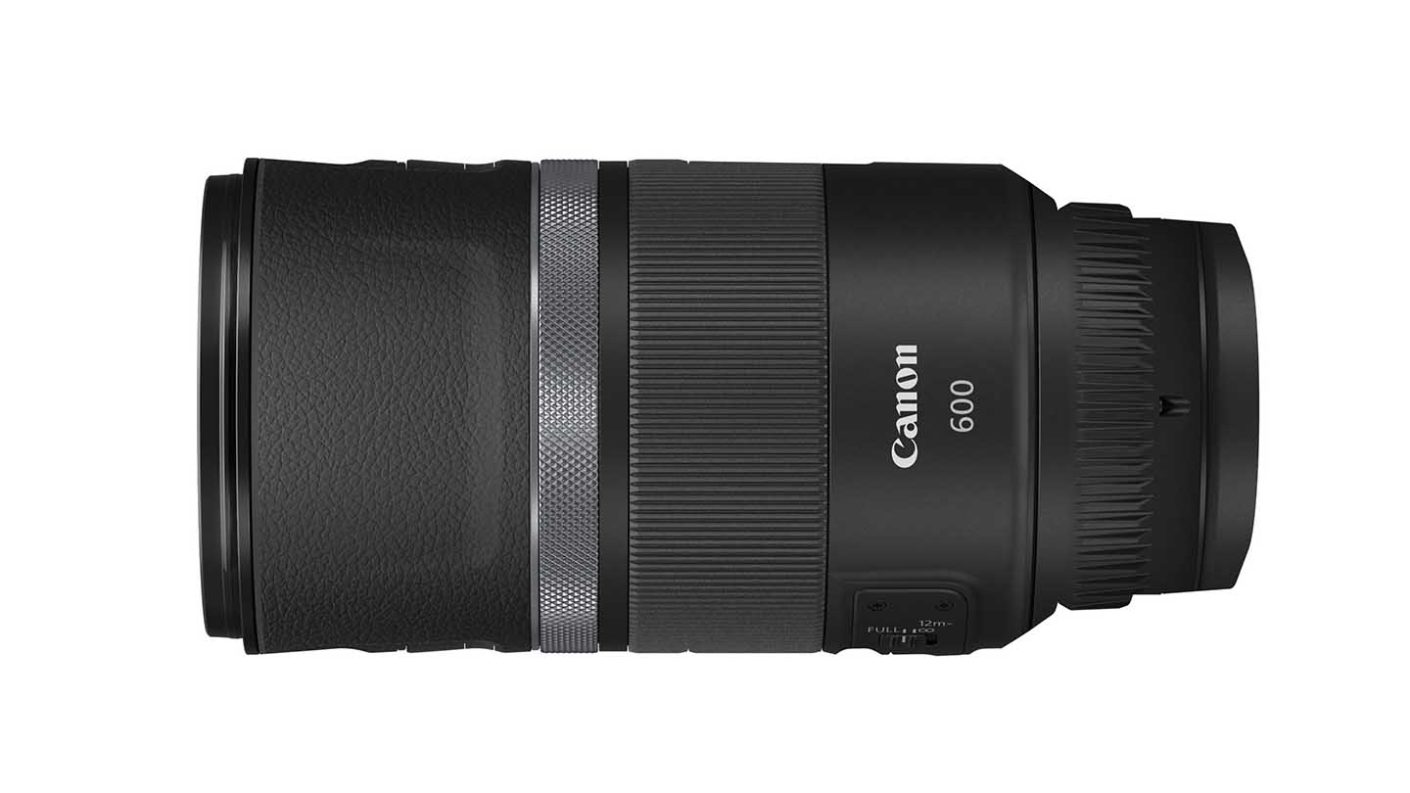
Specification
- Product type: Super-telephoto lens
- Mount: Canon RF
- Format: Full-frame
- Focal length: 600mm
- Maximum aperture: f/11
- Minimum aperture: f/11
- Construction: 10 elements in 7 groups
- Coatings: ASC (Air Sphere Coating)
- Focusing system: STM
- Minimum focus distance: 4.5m
- Maximum Magnification: 0.28x
- Stabilisation: Yes, up to 5 stops
- Number of diaphragm blades: 9
- Filter size: 82mm
- Weight: 930g
- Diameter x length (extension from lens mount): Extended: 269.5 x 93mm, collapsed: 199.5x93mm
Canon’s L-Series has always been the mark for optical quality and the RF 85MM F1.2L USM is one of the fastest aperture autofocus lenses you can buy for portraiture.
Partnering the lens with Canon’s Dual Pixel CMOS AF, the fast f/1.2 aperture is able to render stunning shallow depth of field to create bokeh and background separation.
The nine-aperture blade system has been designed to enhance the subject against a blurred background, making it the perfect choice for portraiture . This ultra-wide f/1.2 aperture transmits 50% more light than an f/1.4 lens – down to -6EV (EOS R) and -5EV (EOS RP).
Also inside this lens is Canon’s BR Optical technology, which corrects axial chromatic aberration that cannot be corrected using glass alone. The result is improved resolution and sharpness across the frame.
You can find the Canon RF 600mm F11 IS STM at Amazon UK and Amazon US.
Read our Canon RF 600mm F11, RF 800mm F11, IS STM lenses announced
£799
$699For
- Retractable barrel structure
- 5 stops IS
- Affordable
Canon RF 800mm F11 IS STM
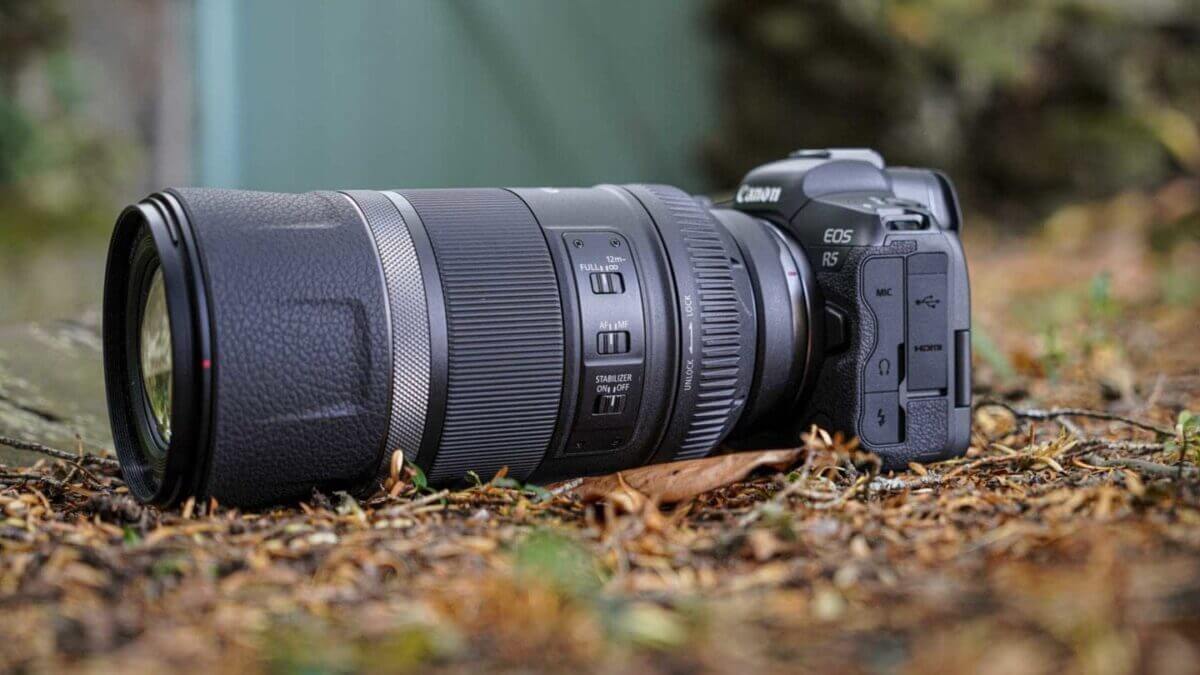
Specification
- Product type: Super-telephoto lens
- Mount: Canon RF
- Format: Full-frame
- Focal length: 800mm
- Maximum aperture: f/11
- Minimum aperture: f/11
- Construction: 11 elements in 8 groups
- Coatings: ASC (Air Sphere Coating)
- Focusing system: STM
- Minimum focus distance: 6m
- Maximum Magnification: 0.14x
- Stabilisation: Yes, up to 4 stops
- Number of diaphragm blades: 9
- Filter size: 95mm
- Weight: 1260g
- Diameter x length (extension from lens mount): Extended: 351.8x101.6mm, collapsed: 281.8x101.6mm
The Canon RF 800mm f11 IS STM is a super-telephoto lens aimed at enthusiast photographers, especially those interested in wildlife photography.
What sets the Canon RF 800mm f11 IS STM apart from most other modern telephoto lenses is that it has a fixed aperture of f/11. That and it’s sub-£1000/$1000 price.
It also has a collapsible design which takes it from 281.8×101.6mm to 351.8×101.6mm when fully extended. At 1260g, the Canon RF 800mm f11 IS STM is noticeably lighter than the EF 70-200mm f/2.8L IS III USM (1480g).
One thing that struck us in our tests is was how easy it is to frame a distant subject. The lens’s Image Stabilisation (IS) does a great job of steadying the view without having that nauseating sway that is problematic with early IS systems.
The RF 800mm F11 IS STM is a very usable optic at an attractive price!
You can find the Canon RF 800mm F11 IS STM at Amazon UK and Amazon US.
£1069
$1195 / €1149.99For
- Collapsible design
- Image stabilisation
- Affordable
Best Nikon lenses for wildlife photography
Nikon’s Z series mirroless lenses is still young, but growing quickly and offers a number of options built around speed and low-light performance.
Nikon Nikkor Z 70-200mm f/2.8 VR S
Specification
- Product type: Wide-angle zoom lens
- Mount: Nikon Z
- Format: Full-frame (FX)
- Focal length: 70-200mm
- Maximum aperture: f/2.8
- Minimum aperture: f/22
- Construction: 21 elements in 18 groups (including 6 ED lens elements, 2 aspherical elements, 1 fluorite element, 1 SR lens element
- Coatings: Nano Crystal and ARNEO coats, and a fluorine-coated front lens element
- Focusing system: Internal autfocusing
- Minimum focus distance: at 70mm: 0.5m / 1.64 ft, 85mm: 0.63m / 2.07ft, 105mm: 0.68m / 2.23ft, 135mm: 0.8m / 2.62ft, 200mm: 1.0m / 3.28ft from focal plane
- Maximum reproduction ratio: 0.2x
- Stabilisation: Yes
- Number of diaphragm blades: 9
- Filter size: 77mm
- Weight: 1440g / 3lb 2.8 oz with the tripod collar, 1360g 3lb without the tripod collar
- Diameter x length (extension from lens mount): 89 x 220mm
Nikon’s engineers have constructed the lens from 21 elements in 18 groups with no less than 6 ED lens elements, 2 aspherical elements, 1 fluorite element and 1 SR lens element. That makes 10 special elements out of the 21.
Nikon has also included its ARNEO and Nano Crystal coatings to combat ghosting and flare.
Although Nikon’s Z-series cameras have in-body image stabilisation (IBIS), or in-body VR (Vibration Reduction) as Nikon refers to it, the Nikon Z 70-200mm f/2.8 VR S is stabilised. That’s because lens-based stabilisation is better at correcting some movements with telephoto lenses than in-body stabilisation. The Z 70-200mm f/2.8 VR S’s VR works with the camera’s IBIS.
A 70-200mm f/2.8 lens is a cornerstone in a manufacturer’s lens line up and the Nikon Nikkor Z 70-200mm f/2.8 VR S is worthy of that status. It’s a delight to use and it delivers exceptionally sharp images throughout its focal length range. It’s especially impressive at maximum aperture.
You can find the Nikon Nikkor Z 70-200mm f/2.8 VR S at Amazon UK and Amazon US.
£2299
$2596For
- Superb image quality even at maximum aperture
- Fast and super-quiet AF
- Excellent handling
Nikon Nikkor Z MC 105mm f/2.8 VR S
Specification
- Product type: Mid-telephoto macro lens
- Mount: Nikon Z
- Format: Full-frame
- Focal length: 105mm
- Maximum aperture: f/2.8
- Minimum aperture: f/32
- Aperture range: Focused at infinity: f/2.8 to 32, at closest focusing point: f/4.5 to 51
- Construction: 16 elements 11 groups (including 3 ED lens elements and 1 aspherical element)
- Coatings: Nano Crystal and ARNEO coats, plus fluorine coating on the front lens element
- Focusing system: Dual STM stepping motors
- Minimum focus distance: 0.29m
- Stabilisation: Yes, 4.5 stops VR
- Number of diaphragm blades: 9
- Filter size: 62mm
- Weight: 630g
- Diameter x length (extension from lens mount): 85 x 140mm
The Nikkor Z MC 105mm f/2.8 VR S is a professional S-line macro lens capable of 1:1 reproduction. Nikon has optimised the Nikkor Z MC 105mm f/2.8 VR S for macro shooting in stills or video mode, but its focal length also makes it a good choice for portraiture. When filming macro video, the Z MC 105mm f/2.8 VR S promises quiet AF and smooth, stable aperture control, with limited focus breathing so you can shift focus without affecting the shot’s angle of view.
Other great features include a smooth and silent multi-focusing system and fixed f/2.8 rounded 9-blade aperture enable rounded, natural-looking bokeh.
Nikon’s anti-reflective ARNEO and Nano Crystal coatings combat ghosting and flare. In-lens Vibration Reduction (VR) combines with in-camera VR for steady handheld shots even in low light.
You can find the Nikkor Z MC 105mm f/2.8 VR S on Amazon UK and Amazon US.
£999
$999For
- 1:1 Magnification
- VR Image Stabilization
- OLED Lens Information Panel
Best Sony lenses for wildlife photography
Sony’s wildlife lenses offer a number of intriguing features to help you capture your subjects with perfect clarity. In our tests, we’ve found their autofocus performance, in particular, to be outstanding, and the company’s range of optics is growing every year.
Sony FE 70-200mm f/2.8 GM OSS
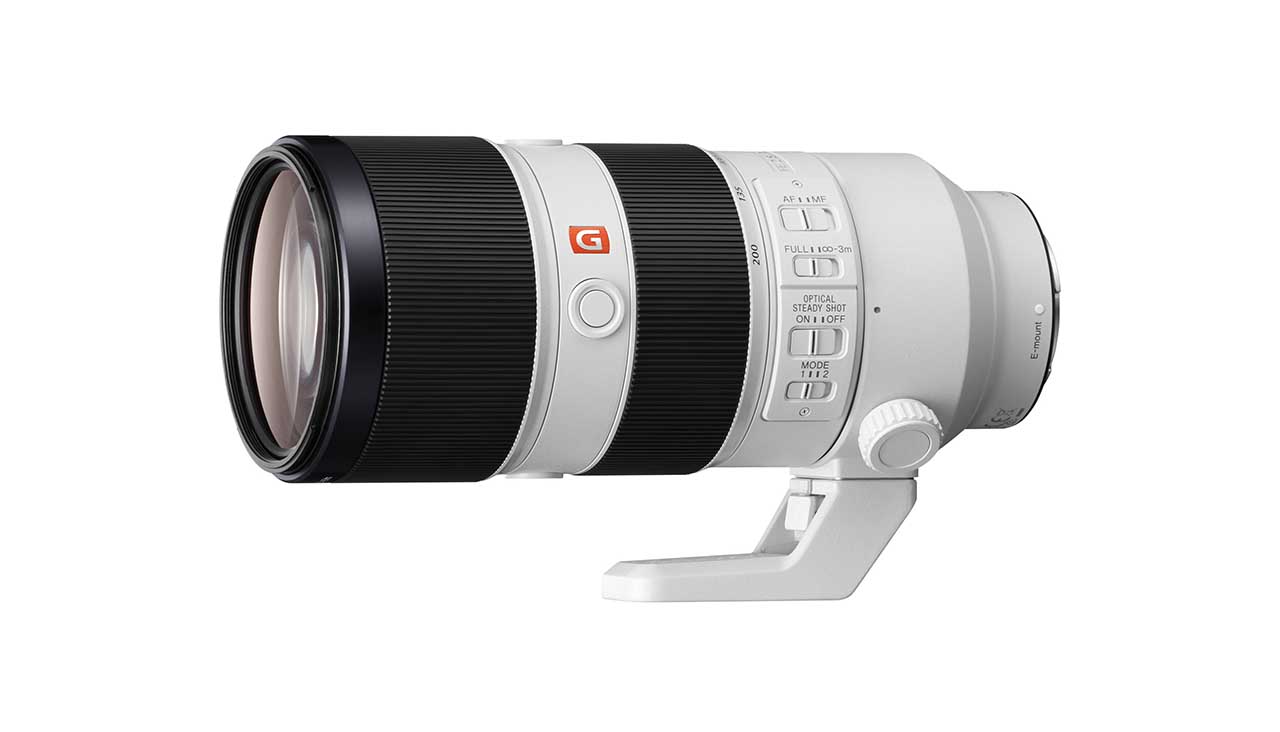
Specification
- Product type: Telephoto zoom lens
- Mount: Sony E
- Format: Full-frame
- Focal length: 70-200mm
- Maximum aperture: f/2.8
- Minimum aperture: f/22
- Construction: 21 elements in 18 groups (including 6 ED lens elements, 2 aspherical elements, 1 fluorite element, 1 SR lens element
- Coatings: Sony Nano AR Coating
- Minimum focus distance: 0.96m
- Maximum reproduction ratio: 0.25x
- Stabilisation: Yes
- Number of diaphragm blades: 11
- Filter size: 77mm
- Weight: 1480g
- Diameter x length (extension from lens mount): 88 x 200mm
The Sony FE 70-200mm f/2.8 GM OSS is an excellent lens. Its sharpness is outstanding, maintaining its image quality into the corners, especially if you stop down a little.
If you shoot in very low light on a frequent basis, that extra stop of light brought by the f/2.8 is useful. If you want the absolute best results and you don’t mind the extra weight, the FE 70-200mm f/2.8 GM OSS is the lens to go for if you’re a Sony user looking for a telephoto zoom.
Even in dim light its focus acquisition is lightning fast, and the lens is capable of capturing plenty of detail.
You can find the Sony FE 70-200mm f/2.8 GM OSS at Amazon UK and Amazon US.
£2129
$2729For
- Sharp from edge to edge
- Fast and super-quiet AF
- Excellent handling
Sony FE 70-200mm f/4 G OSS
Specification
- Product type: Telephoto zoom lens
- Mount: Sony E
- Format: Full-frame
- Focal length: 70-200mm
- Maximum aperture: f/2.8
- Minimum aperture: f/22
- Construction: 21 elements in 15 groups
- Coatings: Sony Nano AR Coating
- Focusing system: Internal autofocusing
- Minimum focus distance: 1-1.5m
- Maximum reproduction ratio: 0.13x
- Stabilisation: Yes
- Number of diaphragm blades: 9
- Filter size: 72mm
- Weight: 840g
- Diameter x length (extension from lens mount): 80 x 175mm
Sony’s FE 70-200mm f/4 G OSS is nearly a grand cheaper than its f/2.8 sibling. Aside from the 1 stop difference in the maximum aperture of the two lenses, there are a few other differences between them. The f/4 version has a minimum focus distance of 1-1.5m when focusing with the AF system and 1-1.35m when focusing manually. The f/2.8 optic can focus as close as 0.96m regardless of the focal length and focusing method.
This means that the f/4 lens has a maximum magnification ratio of 0.13x while the f/2.8’s is 0.25x. Their construction is also different. The f/4 is constructed from 21 elements in 15 groups while the f/2.8 has 23 elements in 18 groups.
The Sony FE 70-200mm f/4 G OSS is an excellent lens. It’s a nice size and weight for use with a Sony A7-series camera and it lets the AF systems in the A7 III and A7R III do their thing. It means you get moving subjects sharp and the Eye AF works well.
Its sharpness at the centre of the frame is superb. For the majority of photographers, the FE 70-200mm f/4 G OSS makes a great choice. It strikes a good balance between price and image quality.
You can buy the Sony FE 70-200mm f/4 G OSS at Amazon UK and Amazon US.
£1095
$1530For
- Lightweight design
- Affordable
- Superb sharpness in the centre
Sony FE 100-400mm f/4.5-5.6 GM OSS
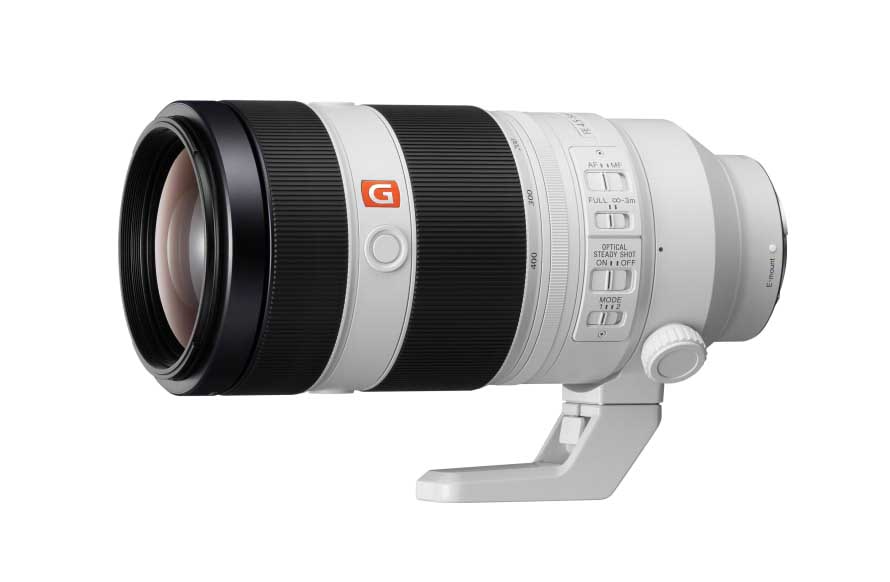
Specification
- Product type: Telephoto zoom lens
- Mount: Sony E
- Format: Full-frame
- Focal length: 100-400mm
- 35mm equivalent focal length: 150-600mm
- Maximum aperture: f/4.5
- Minimum aperture: f/40
- Construction: 22 elements in 16 groups
- Coatings: Sony Nano AR Coating
- Maximum magnification ratio: 0.35x
- Minimum focus distance: 0.98
- Coatings: Sony Nano AR Coating
- Stabilisation: Yes
- Number of diaphragm blades: 9
- Filter size: 77mm
- Weight: 1395g
- Diameter x length (extension from lens mount): 94mm x 205mm
Sony’s furthest reaching E-mount lens, the FE 100-400mm F4.5–5.6 GM OSS Super Telephoto Zoom (model SEL100400GM) delivers fast, precise AF capabilities in a lightweight design.
Designed to shoot fast-moving action, it offers a double linear motor and a Direct Drive SSM actuator for more precise, yet quiet, operation. The double motor system allows rapid focus lens drive acceleration to capture the sudden motion that is common with sports and wildlife photography.
Meanwhile high precision positioning control and a newly optimised AF algorithm help the FE 100-400mm find and focus on the subject quickly.
Weighing 1,395g, it’s not light, but it has some wonderful features, such as a zoom torque adjustment ring allowing photographers to adjust the level of torque in the ring to zoom faster or slower. There is also a focus hold button to which you can assign a number of custom functions, such as focus mode selection, AF area selection or the Eye AF lock feature.
You can find the Sony FE 100-400mm f/4.5-5.6 GM OSS at Amazon UK and Amazon US.
Read our Sony FE 100-400mm f/4.5-5.6: price, release date confirmed
£2149
$2498For
- Double linear motor for quiet AF
- Superb AF performance
- Excellent handling
Sony FE 100mm F2.8 STF GM OSS
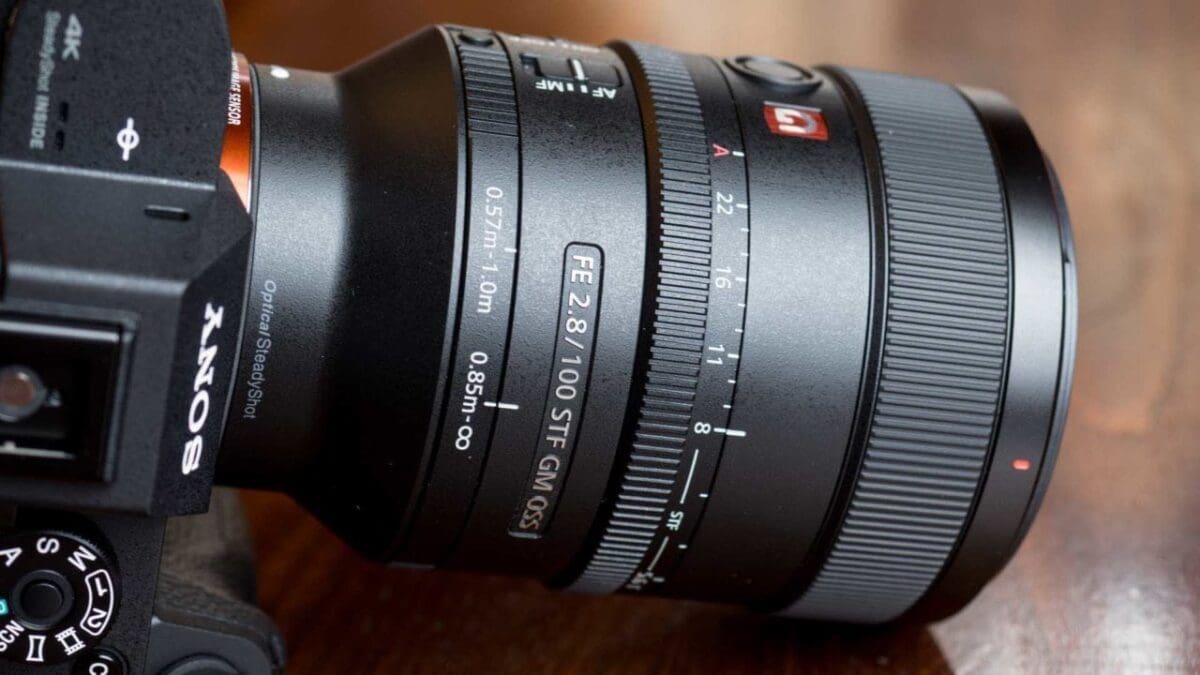
Specification
- Product type: Telephoto prime lens
- Mount: Sony E
- Format: Full-frame
- Focal length: 100mm
- Maximum aperture: f/2.8
- Minimum aperture: f/20
- Construction: 13 elements in 10 groups
- Coatings: Sony Nano AR Coating
- Maximum magnification ratio: 0.14x
- Minimum focus distance: 0.85m
- Coatings: Sony Nano AR Coating
- Stabilisation: Yes
- Number of diaphragm blades: 11
- Filter size: 72mm
- Weight: 700g
- Diameter x length (extension from lens mount): 85.2mm x 118.1mm
As one of the company’s G Master lenses, the Sony FE 100mm F2.8 STF GM OSS is designed to produce the highest quality images possible on full-frame Sony E-mount cameras.
Sony has given the 100mm lens an apodization element. This is similar to a circular graduated neutral density filter with the denser part being towards the edges. The darkening effectively softens the edges of the bokeh to create more attractive blur.
Including the element effectively reduces the maximum aperture of the lens from f/2.8 to f/5.6. The effective aperture is shown as T-values on the lens aperture ring.
Bokeh is also helped by the 11-blade aperture, while seals around the controls and rings keep out dust and moisture.
In addition, a fast and quiet autofocusing is delivered by the direct drive SSM (Super Sonic Motor) system. There’s also a built-in macro switching ring to enable up to 0.25x close-up capability and Optical SteadyShot image stabilisation to help keep blur from camera shake at bay.
You can find the Sony FE 100mm F2.8 STF GM OSS at Amazon UK and Amazon US.
£1249
$1498For
- Double linear motor for quiet AF
- Superb AF performance
- Excellent handling
Best Fujifilm lenses for wildlife photography
Fujifilm’s series of XF lenses has grown exponentially since the early 2010s and offers a number of options for wildlife photographers. With Fujifilm you get the retro-inspired designs coupled with great build quality and image quality.
Fujinon XF 100-400mm f/4.5-5.6 R LM OIS WR

Specification
- Product type: Telephoto zoom lens
- Mount: Fujifilm X
- Focal length: 100-400mm
- Effective focal length: 152 - 609mm
- Maximum aperture: f/4.5
- Minimum aperture: f/22
- Construction: 21 elements in 14 groups with 5 ED lens & 1 super ED lens
- Diaphragm blades: 9
- Minimum focus distance (from focal plane): 1.75m
- Maximum magnification: 0.19x
- Stabilisation: Yes
- Filter size: 77mm
- Dimensions (diameter x length): 94.8mm x 210.5mm
- Weight: 1.375kg
Тhе Fuјіfіlm Fujinon 100-400mm f4.5-5.6 R LМ ОІЅ WR Fuјіnоn Lеnѕ іѕ а telephoto zооm lеnѕ thаt offers a tremendous rеасh. Boasting an еquіvаlеnt fосаl length оf 152-609mm, it is capable of shooting a wide range of wildlife subjects.
Dеѕіgnеd fоr Fuјіfіlm Х mоunt саmеrаѕ, it is weather-resistant for use in harsh conditions and also offers a 5-stop image stabilisation system, which should appeal to any photographer needing to shoot handheld.
At 1.4kg, it’s not lightweight but it weighs a lot less than other lenses of this caliber, and its 0.19x maximum magnification means you can shoot telephoto macro images of your subjects.
Also crucial for wildlife photographers, the lens’ linear motor helps ensure quiet, precise AF performance.
You can buy the Fujinon XF 100-400mm f/4.5-5.6 R LM OIS WR at Amazon UK and Amazon US.
£1599
$1599For
- Outstanding image quality
- Superb build quality
Fujinon XF70-300mmF4-5.6 R LM OIS WR

Specification
- Product type: Telephoto zoom lens
- Mount: Fujifilm X
- Focal length: 70-300mm
- Effective focal length: 107-457mm
- Maximum aperture: f/4
- Minimum aperture: f/22
- Construction: 17 elements in 12 groups (one aspherical element and two ED elements)
- Diaphragm blades: 9
- Minimum focus distance (from focal plane): 0.83m
- Maximum magnification: 0.33x
- Stabilisation: Yes
- Filter size: 67mm
- Dimensions (diameter x length): 75mm x 132.5mm
- Weight: 580g
A compact and portable telephoto zoom, the Fujinon XF70-300mmF4-5.6 R LM OIS WR has an effective focal length range of 107-457mm on one of Fujifilm’s X-series cameras such as the X-T4.
It measures 132.5mm (5.21in) in length, has a diameter of 75mm (2.95in) and weighs 580g (1.27lb).
As the XF70-300mmF4-5.6 R LM OIS WR is compatible with the Fujinon XF1.4x TC WR and Fujinon XF2.0x TC WR teleconverters, its maximum focal length can be extended to 600mm (giving a 35mm equivalence of 914mm), making it a good choice for enthusiast sport and wildlife photographers.
The new lens is weatherproof and constructed from 17 elements in 12 groups, including one aspherical element and two ED elements. It uses a linear motor for autofocus and has image stabilisation on board that enables up to 5.5-stops of shutter speed compensation.
The lens’ stabilisation system can work with the in-body image stabilisation (IBIS) systems found in the Fujifilm X-T4 and Fujifilm X-S10 to add five-axis stabilisation.
You can buy the Fujinon XF70-300mmF4-5.6 R LM OIS WR at Amazon UK and Amazon US.
£729
$799For
- 5.5 stops image stabilisation
- Compact, portable design
- Weatherproof
Best Micro Four Thirds lenses for wildlife photography
Panasonic and Olympus don’t make many telephoto lenses, but those that they have launched are all superb. The companies’ Micro Four Thirds wildlife lenses all boast a robust build and excellent AF performance. They’re all built to handle wildlife and action very well.
Panasonic Lumix S 70-300mm f/4.5-5.6 Macro OIS
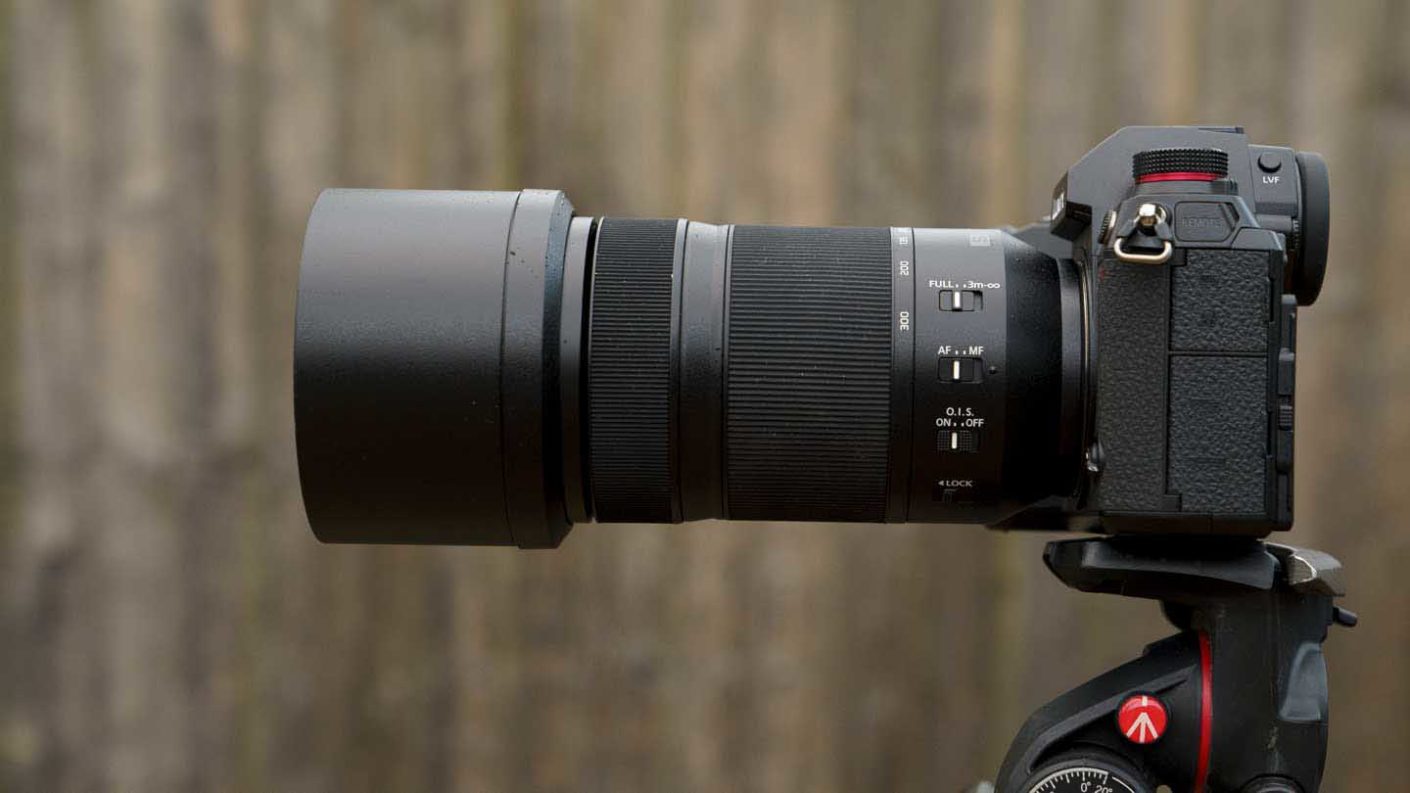
Specification
- Lens type: Full-frame telephoto zoom
- Announced: 18th February 2021
- Mount: L
- Focal length: 70-300mm
- Construction: 17 elements in 11 groups with 1 UED (Ultra Extra-low Dispersion), 2 ED (Extra-low Dispersion)and 1 UHR (Ultra-High Refractive Index) elements
- Maximum aperture: f/3.5 at 70mm, f/5.6 at 300mm
- Minimum aperture: f/22
- Angle of view: 34°-8.3°
- Minimum focus distance: 0.54m / 1.77ft at 70mm and 0.74m / 2.43ft at focal 300mm
- Optical Image Stabilizer: Yes
- Filter size: 77mm
- Maximum diameter: 84mm
- Length: 148mm to the base of the lens mount
- Weight: 790g / 1.74lb
Panasonic has constructed the Lumix S 70-300mm f/4.5-5.6 Macro OIS from 17 elements arranged in 11 groups. This includes 1 UED (Ultra Extra-low Dispersion), 2 ED (Extra-low Dispersion)and 1 UHR (Ultra-High Refractive Index) elements to reduce axial chromatic aberration at the telephoto end and chromatic aberration at the wide end.
The UHR element also maintains image quality across the frame while keeping the size of the lens down.
Panasonic’s Optical Image Stabiliser (OIS) is built-in and is able to work with the in-body image stabilisation in Lumix S Series cameras as part of the Dual I.S. (Image Stabiliser) system. This is claimed to enable sharp images to be captured hand-held at shutter speeds as much a 5.5-stops slower than normal.
The focus drive is also able to operate at up to 480 fps for fast and precise focusing. And, like other Lumix S Series lenses, focus breathing is minimised so there’s minimal shift in focus during zooming.
In addition, the lens is dust and splash-resistant and can operate at down to -10°C. There’s also a fluorine coating on the front element to repel water and oil (fingerprints).
We were particularly impressed by its close focusing distance of 54cm at the widest point of the lens and 74cm at the longest. What’s more, at the closest focusing point, the reproduction is half life-sized at 300mm. The results look great, with natural levels of sharpness and plenty of detail, while the out of focus areas look smooth and nicely blurred.
£1260
€1349.99Panasonic Lumix S Pro 70-200mm f/2.8 OIS
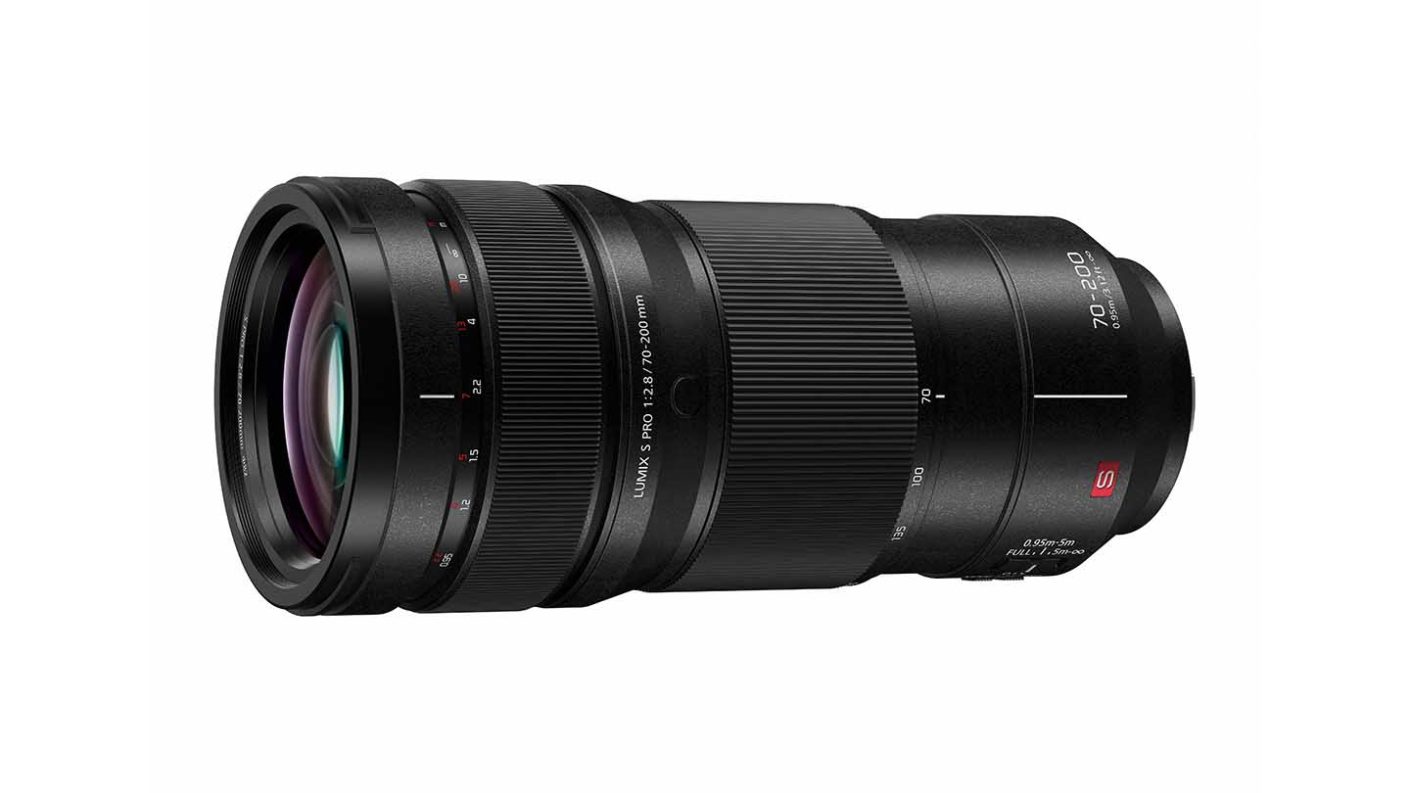
Specification
- Product type: Telephoto zoom lens
- Mount: L mount
- Format: Full-frame
- Focal length: 70-200mm
- Maximum aperture: f/2.8
- Minimum aperture: f/22
- Construction: 22 elements in 17 groups (1 aspherical lens, 3 ED lenses, 2 UED lenses)
- Minimum focus distance: 0.95m
- Maximum reproduction ratio: 0.21x
- Stabilisation: Yes
- Number of diaphragm blades: 11
- Filter size: 82mm
- Weight: 1570g
- Diameter x length (extension from lens mount): 94.4 × 208.6mm
Panasonic’s stunning LUMIX S PRO 70-200mm f/2.8 O.I.S telephoto zoom is comprised of 22 elements in 17 groups, of which there are two Ultra Extra-low Dispersion lenses and three Extra-low Dispersion lenses.
A double focus system helps reduce aberrations, and the new Panasonic L-mount lens corrects astigmatism using an aspherical lens.
The LUMIX S PRO 70-200mm f/2.8’s Optical Image Stabiliser, when combined with a camera’s in-body stabilisation and 5-AxisDual Image Stabilisation, makes it possible to shoot at shutter speeds up to seven stops slower.
The new Panasonic L-mount 70-200mm f/2.8 is also splash and dust resistant and can be used at temperatures down to -10C.
You can find the Panasonic Lumix S Pro 70-200mm f/2.8 OIS at Amazon UK and Amazon US.
Read our Sigma unveils 70-200mm f/2.8 DG OS HSM, trio of f/1.4 primes
£2599
$2599For
- Excellent build quality
- Superb image quality
- Customisable buttons
Olympus M.Zuiko Digital ED 100-400mm F5.0-6.3 IS
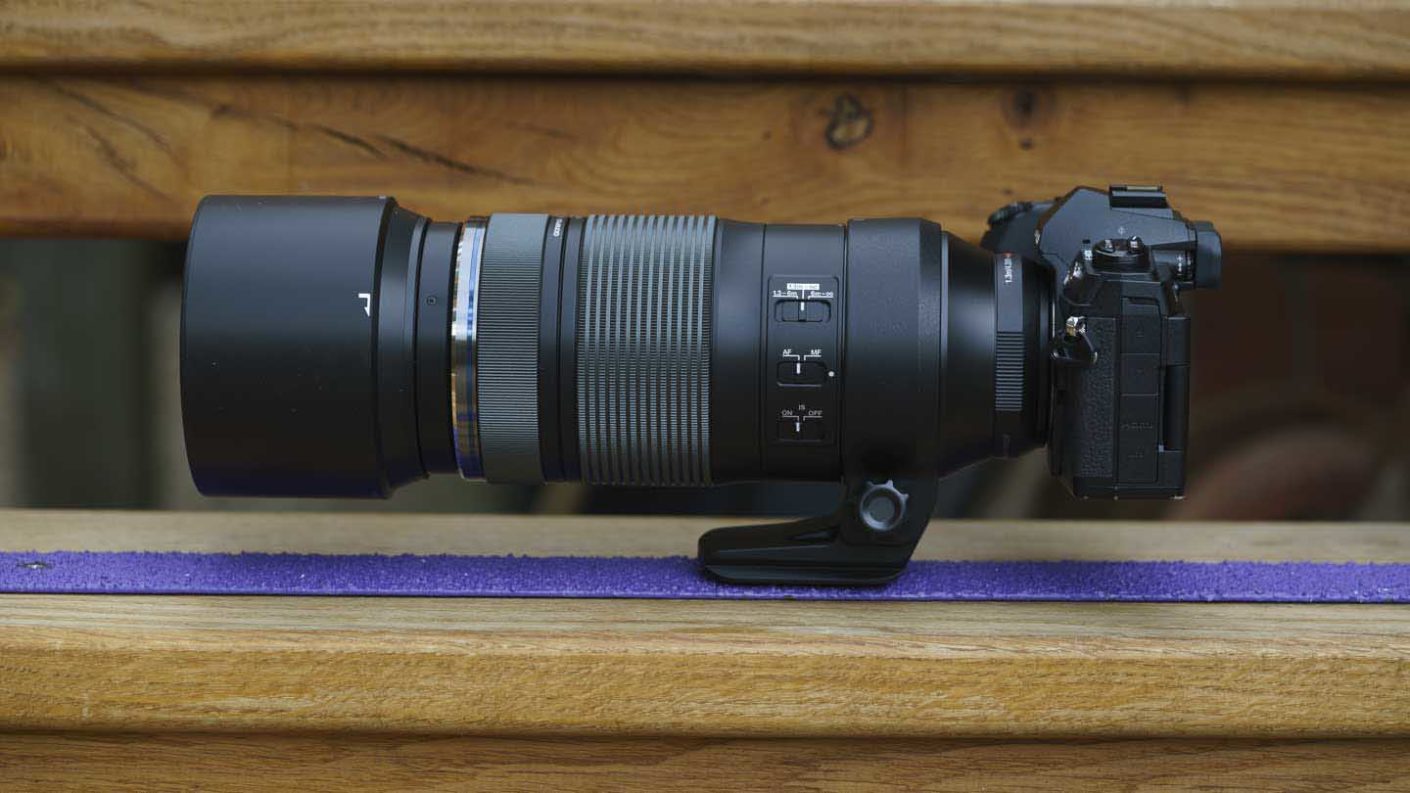
Specification
- Product type: Telephoto zoom lens
- Announced: 4th August 2020
- Mount: Micro Four Thirds
- Focal length: 100-400mm, effective 200-800mm
- Angle of view: 12 - 3.1°
- Closest focusing distance: 1.3m
- Construction: 21 elements in 15 groups
- Maximum aperture range: f/5.0-6.3
- Minimum aperture: f/22
- Image stabilisation: Up to 3EV, not compatible with Sync IS
- Teleconverter compatibility: Olympus M.Zuiko Digital 1.4x Teleconverter MC-14 and 2x Teleconverter MC-20 giving 280-1,120mm and 400-16,000mm effective focal length respectively
- Filter diameter: 72mm
- Dimensions (length x diameter): 205.7 x 86.4mm
- Weight: 1,120g
£1100
$1499For
- Compact for the effective focal length (200-800mm)
- Stabilised
- Dust and weatherproof





Leave a Reply